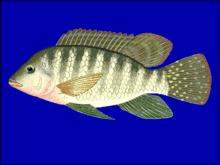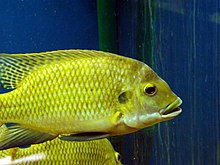Redbelly tilapia
| Redbelly tilapia | |
|---|---|

| |

| |
| Scientific classification | |
| Kingdom: | Animalia |
| Phylum: | Chordata |
| Class: | Actinopterygii |
| Order: | Cichliformes |
| Family: | Cichlidae |
| Genus: | Coptodon |
| Species: | C. zillii
|
| Binomial name | |
| Coptodon zillii (Gervais, 1848)
| |
| Synonyms[2] | |
| |
The redbelly tilapia (Coptodon zillii, syn. Tilapia zillii), also known as the Zille's redbreast tilapia or St. Peter's fish (a name also used for other tilapia in Israel), is a species of fish in the cichlid family. This fish is found widely in fresh and brackish waters in the northern half of Africa and the Middle East.[1][3] Elsewhere in Africa, Asia, Australia and North America, it has been introduced as a food fish or as a control of aquatic vegetation. Where introduced, it sometimes becomes invasive, threatening the local ecology and species.[3][4][5][6] The redbelly tilapia is an important food fish and sometimes aquacultured.[3][4]
The species was named by Paul Gervais in honor of M. (probably Monsieur) Zill, a “distinguished naturalist” who collected the type specimen and sent it to Gervais.[7][failed verification]
Native distribution and taxonomy[]
In Africa, the native range of the redbelly tilapia covers the northern half of the continent. In tropical West to Central Africa, from coastal southern Morocco and the Senegal River to the central Congo River basin, its range is almost continuous.[3][8] In northeastern Africa the redbelly tilapia occurs throughout much of the Nile basin, from its delta in northern Egypt to Lake Albert in DR Congo–Uganda, as well Lake Turkana in Ethiopia–Kenya; it is not native to the other African Great Lakes, although it has been introduced to some of them.[1][3][4] In the Maghreb and Sahara where fewer aquatic habitats are available, the range is much more spotty but with several relict populations in seasonal rivers, lakes and oases (gueltas).[8][9] Outside Africa, its natural distribution is limited to the Jordan River system, including Lake Tiberias (Kinneret), in Israel, Jordan and Syria, as well as coastal systems in Israel.[3][10]
Cichlids are numerous in Africa, but in parts of the redbelly tilapia's range it is one of the few members of the family. In the Maghreb and Sahara (excluding the species-rich Nile), the only others are the blue tilapia (Oreochromis aureus) and mango tilapia (Sarotherodon galilaeus), and a couple of Astatotilapia and Hemichromis species.[8][9][11] In Western Asia, the only other native cichlids are a few species of oreochromine tilapias and the Jordan mouthbrooder (Astatotilapia flaviijosephi).[10][12]
Although genetic studies have shown that most populations of the redbelly tilapia are very closely related,[13] a few from the outer margins of its range are of questionable taxonomic status and require further study. A population in the Kisangani region, although closely related, appears to be separate.[13] Similarly, those found in coastal northwestern Africa are genetically quite distinct from the other populations.[8] In the Nile system, it has been observed that populations in its delta, the northern White Nile and lakes near Fayum differ from each other in morphology and colors, but whether this is taxonomically significant is unclear. In contrast, the virtually unknown C. ismailiaensis of northeastern Egypt might only be an aberrant redbelly tilapia; it primarily differs in its unspotted tail.[14]
Habitat and ecology[]
The redbelly tilapia has a preference for shallow waters with vegetation,[3] but it also occurs in more open habitats like sandy shores and as deep as 30 m (100 ft).[1]
Although primarily a species of fresh and brackish water habitats, it tolerates high salinities, up to 4% (sea water is c. 3.5%), but the upper breeding limit is at 2.9%.[10] The redbelly tilapia also can live in a wide range of water temperatures, but in the northern part of its range it sometimes falls below its requirements (minimum 6.5–13 °C [43.7–55.4 °F], depending on a range of factors), resulting in large numbers dying.[10] In Alabama, it was necessary to introduce them each year to maintain a population, as they die during the winter.[5] The upper limit typically is 36 °C (97 °F), but it can survive to 42.5 °C (108.5 °F).[3]
Appearance[]
The redbelly tilapia can reach up to 300 g (11 oz) in weight and 40 cm (16 in) in length, but usually is no more than 30 cm (12 in).[3] In the Middle East, adults typically are 12–22 cm (5–9 in) long.[10] Males tend to grow larger than females, but otherwise the sexes are similar.[4]
Its base color is brownish-olivaceous and the belly is yellowish or whitish. It often (for example, when agitated) has a faint/poorly defined dark pattern consisting of two horizontal lines on the body crossed by about half a dozen vertical bars. Breeding adults are more greenish overall, have iridescent blue-green spots on the head and bright pinkish-red underparts.[3][15] This species very closely resembles the redbreast tilapia (C. rendalli) and the two are difficult to distinguish; many reports of introduced populations may involve either species.[4][5] The two have separate natural distribution (redbelly tilapia in the northern half of Africa, redbreast tilapia in the southern half), but through introductions their ranges now overlap. Whether they can hybridize is unknown.[4] It has hybridized with the spotted tilapia (Pelmatolapia mariae),[16] a quite distant relative.[13]
Behavior[]

As typical of Coptodon, the redbelly tilapia is a substrate spawner and brooder. The "nest" typically is a small depression in the bottom that is dug by both parents,[4][5] but sometimes the eggs are placed on the top of a stone or the "nest" is an up to 85-centimetre-deep (2.8 ft) tunnel that is dug into muddy substrate.[10] Several pairs may breed quite closely together forming a colony. Each female lays 1,000–6,000 eggs per spawning and she may spawn multiple times in a season.[15] Both parents guard the eggs and fry.[4][5][10] In tropical locations it breeds year-round, although peaking in the rainy season.[1][5] In colder subtropical regions like Israel it only breeds in the summer,[5][10] at water temperatures of at least 20 °C (68 °F).[15] All other cichlids native to Western Asia are mouthbrooders.[10]
The redbelly tilapia mostly feeds on algae and higher plants (both aquatic plants and land plants that become accessible to the fish), but it also takes smaller quantities of invertebrates and fish eggs.[4][5] Young redbelly tilapias feed extensively on tiny crustaceans.[15]
References[]
- ^ a b c d e Lalèyè, P. (2020). "Coptodon zillii". IUCN Red List of Threatened Species. 2020: e.T183163A64508317. doi:10.2305/IUCN.UK.2020-2.RLTS.T183163A64508317.en. Retrieved 20 November 2021.
- ^ Froese, Rainer and Pauly, Daniel, eds. (2019). "Coptodon zillii" in FishBase. December 2019 version.
- ^ a b c d e f g h i j Froese, Rainer and Pauly, Daniel, eds. (2019). "Coptodon zillii" in FishBase. November 2019 version.
- ^ a b c d e f g h i Genner, M.J.; G.F. Turner; B.P. Ngatunga (2018). "A Guide to Tilapia Fishes of Tanzania" (PDF). Retrieved 10 November 2019.
- ^ a b c d e f g h Nico, L.; M. Neilson; B. Loftus (2019). "Tilapia zillii (Gervais, 1848)". U.S. Geological Survey, Nonindigenous Aquatic Species Database. Retrieved 10 November 2019.
- ^ "Tilapia zillii (redbelly tilapia)". CABI – Invasive Species Compendium. 2019. Retrieved 13 November 2019.
- ^ Christopher Scharpf & Kenneth J. Lazara (22 September 2018). "Order CICHLIFORMES: Family CICHLIDAE: PSEUDOCRENILABRINAE (a-g)". The ETYFish Project Fish Name Etymology Database. Christopher Scharpf and Kenneth J. Lazara. Retrieved 19 February 2021.
- ^ a b c d Clavero, M.; A. Qninba; M. Riesco; J. Esquivias; J. Calzada; M. Delibes (2017). "Moroccan desert rivers: fish on the arid extreme of Mediterranean streams". Fishes in Mediterranean Environments. 003: 1–21. doi:10.29094/FiSHMED.2017.003.
- ^ a b Trape, S. (2016). "A new cichlid fish in the Sahara: The Ounianga Serir lakes (Chad), a biodiversity hotspot in the desert". Comptes Rendus Biologies. 339 (11–12): 529–536. doi:10.1016/j.crvi.2016.08.003. PMID 27720144.
- ^ a b c d e f g h i Gophen, M. (2018). Ecological Research in the Lake Kinneret and Hula Valley (Israel) Ecosystems. pp. 252–263.
- ^ Trape, S. (2018). "Epiplatys bifasciatus (Steindachner, 1881) (Nothobranchiidae) and Hemichromis fasciatus Peters, 1852 (Cichlidae), two relict fish species in the Sahara desert". Bonn Zoological Bulletin. 67 (1): 37–40.
- ^ Werner, N.Y.; O. Mokady (2004). "Swimming out of Africa: mitochondrial DNA evidence for late Pliocene dispersal of a cichlid from Central Africa to the Levant". Biological Journal of the Linnean Society. 82 (1): 103–109. doi:10.1111/j.1095-8312.2004.00321.x.
- ^ a b c Dunz, A.R.; U.K. Schliewen (2013). "Molecular phylogeny and revised classification of the haplotilapiine cichlid fishes formerly referred to as "Tilapia"". Molecular Phylogenetics and Evolution. 68 (1): 64–80. doi:10.1016/j.ympev.2013.03.015. PMID 23542002.
- ^ Neumann, D.; H. Obermaier; T. Moritz (2016). "Annotated checklist for fishes of the Main Nile Basin in the Sudan and Egypt based on recent specimen records (2006-2015)". Cybium. 40 (4): 287–317. doi:10.26028/cybium/2016-404-004.
- ^ a b c d "California Fish Website — Tilapia". University of California. 2019. Retrieved 12 November 2019.
- ^ Taylor, J.N.; D.B. Snyder; W.R. Courtenay, Jr. (1986). "Hybridization between Two Introduced, Substrate-Spawning Tilapias (Pisces: Cichlidae) in Florida". Copeia. 1986 (4): 903–909.
| Wikimedia Commons has media related to Coptodon zillii. |
- IUCN Red List least concern species
- Coptodon
- Taxa named by Paul Gervais
- Fish described in 1848
